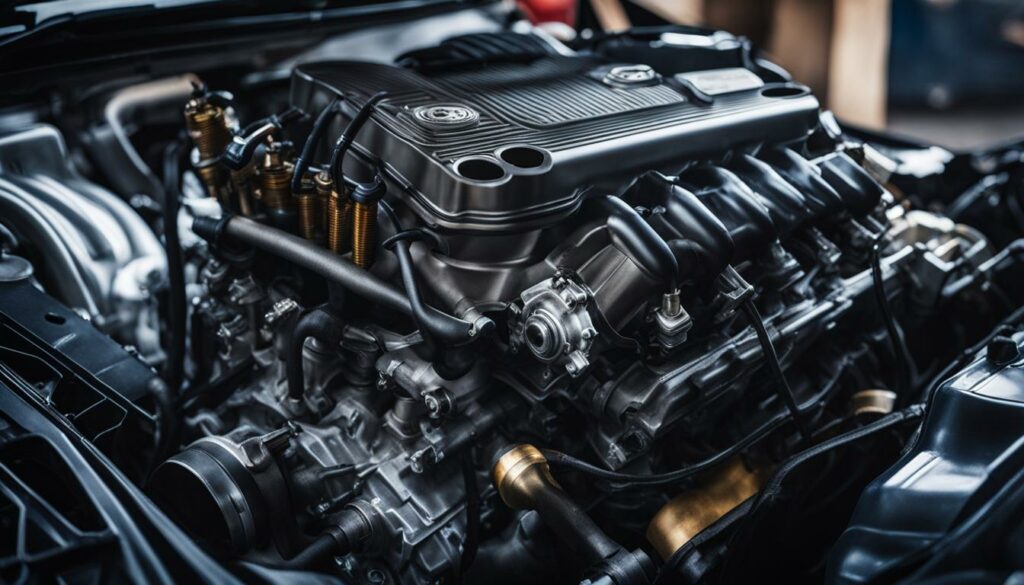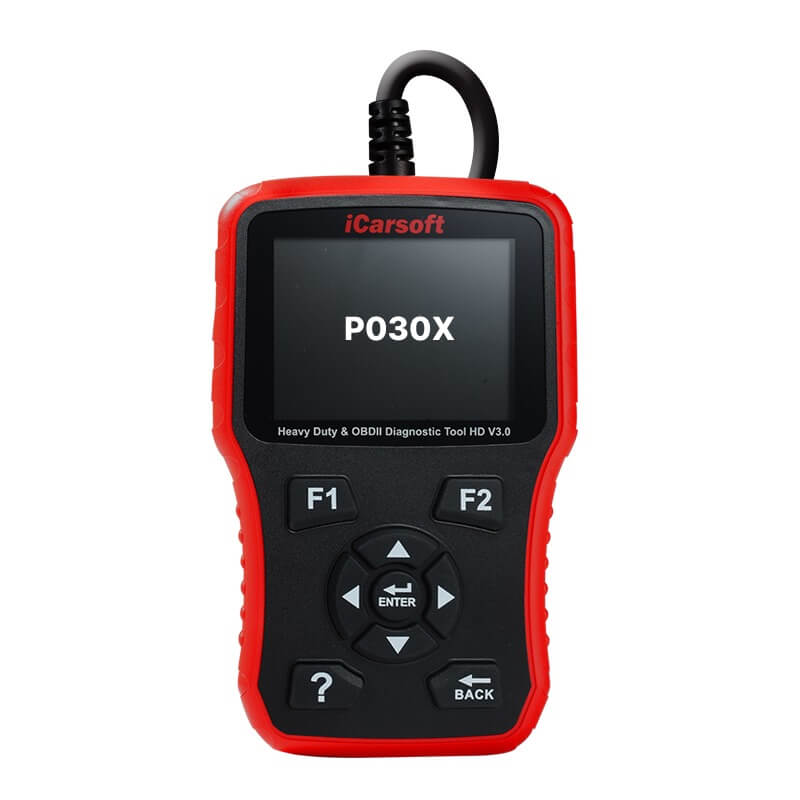P030X – Cylinder X Misfire Detected
POSTED IN pcodes
Welcome to our article on the diagnostic trouble code P030X, indicating a misfire in cylinder X of your engine. Whether you’re experiencing rough idling, lack of power, or have noticed the Check Engine light illuminating, understanding and resolving engine misfires is essential for optimal performance and longevity of your vehicle.
A misfire occurs when there is no combustion or incomplete combustion in a specific cylinder, resulting in a range of performance issues. Driving with a misfiring engine can lead to further damage, including overheating and damage to the catalytic converter. To prevent these issues, timely troubleshooting and fixing of misfire problems are crucial.
Key Takeaways:
- Misfire code P030X indicates a misfire in cylinder X of your engine.
- Common causes of misfires include failed ignition coils, fouled spark plugs, carbon buildup, faulty fuel injectors, and vacuum leaks.
- Symptoms of a misfiring engine may include rough idling, lack of power, Check Engine light illumination, and exhaust smell.
- Diagnosing misfires involves inspection of spark plugs, ignition components, fuel pressure, and detection of vacuum leaks.
- Manufacturers may provide relevant service bulletins and recommendations for addressing engine misfires.
Symptoms of a Misfiring Engine
A misfiring engine can exhibit several noticeable symptoms. It is important to be aware of these symptoms, as they can indicate potential problems with your vehicle’s engine. Here are the common symptoms of a misfiring engine:
- Rough idling: When an engine misfires, you may notice that the engine shakes or runs unevenly when idling or during acceleration. This can create a noticeable vibration in the vehicle.
- Lack of power: A misfire can result in a lack of power, making it difficult for the vehicle to accelerate or maintain speed. You may experience a significant decrease in performance when trying to accelerate or climb hills.
- Check Engine light: If your vehicle’s engine misfires, the “Check Engine” light on the dashboard may illuminate. This warning light is an indicator that a problem has been detected and should not be ignored.
- Exhaust smell: In some cases, there may be a distinct smell coming from the exhaust when the engine is misfiring. This smell can be caused by the incomplete combustion of fuel in the affected cylinder.
It is important to address these symptoms promptly to prevent further damage to the engine and related components. Ignoring engine misfires can lead to more severe issues and costly repairs down the line.

Buy tested tuning file for Adblue / EGR / DPF / Adblue off now!
Now that you’re familiar with the symptoms of a misfiring engine, let’s explore the common causes of engine misfires in the next section.
Common Causes of Engine Misfires
Engine misfires can be frustrating and detrimental to your vehicle’s performance. Understanding the common causes of these misfires can help you diagnose and resolve the issue quickly. Some of the most frequent culprits include:
- Failed Ignition Coil: Ignition coils are responsible for generating the spark that ignites the fuel in the cylinder. When an ignition coil fails, it can cause a misfire in the corresponding cylinder.
- Fouled Spark Plug: Spark plugs can become fouled due to wear, carbon buildup, or damage. When a spark plug is fouled, it can result in an incomplete combustion process and lead to misfires.
- Carbon Buildup: Over time, carbon can accumulate on the intake valves, disrupting the proper flow of air and fuel into the cylinder. This disruption can cause misfires.
- Faulty Fuel Injector: Fuel injectors are responsible for delivering the correct amount of fuel to the cylinder. When a fuel injector malfunctions, it can disrupt the fuel-to-air ratio and cause misfires.
- Vacuum Leak: Vacuum leaks, such as a cracked intake manifold gasket or a disconnected vacuum line, can create a lean air-fuel mixture. This imbalance can result in misfires.
Identifying and addressing these common causes can help resolve engine misfires and restore your vehicle’s optimal performance.

Diagnosing and Fixing Engine Misfires
When dealing with an engine misfire, a systematic approach is crucial for accurate diagnosis and proper repair. Here are some key steps to help you diagnose and fix engine misfires:
1. Spark Plug Inspection
The first step is to visually inspect the spark plugs. Look out for signs of fouling, such as carbon deposits or oil residue. Check for arcing, which can indicate a potential issue. Ensure all spark plugs are in good condition and properly gapped.
2. Ignition Coil Testing
Swapping ignition coils between cylinders can help identify a faulty coil if the misfire follows the coil. Use an appropriate testing tool to check the resistance and functionality of each ignition coil. Replace any faulty coils to ensure a strong and consistent spark.
3. Fuel Pressure Check
Testing the fuel pressure can help determine if there is a problem with the fuel delivery system. Use a fuel pressure gauge to measure the pressure at the fuel rail. Compare the readings with the manufacturer’s specifications. Low fuel pressure can cause lean misfires, while high fuel pressure can cause rich misfires.
4. Vacuum Leak Detection
Vacuum leaks can disrupt the air-fuel mixture and lead to engine misfires. One way to detect vacuum leaks is through smoke testing. Introduce smoke into the intake system and look for any leaks where the smoke escapes. You can also listen for hissing sounds while the engine is running, indicating a potential vacuum leak.
It is important to consult the vehicle’s service manual or seek professional assistance to ensure accurate diagnosis and proper repair of the misfire issue. Depending on the specific cause, fixing the misfire may involve replacing faulty ignition components, cleaning carbon buildup, repairing vacuum leaks, or addressing other underlying causes.
Remember, proper diagnosis and timely repair of engine misfires will not only restore optimal engine performance but also prevent further damage and costly repairs in the long run.
| Steps | Diagnosis Methods |
|---|---|
| 1 | Spark Plug Inspection |
| 2 | Ignition Coil Testing |
| 3 | Fuel Pressure Check |
| 4 | Vacuum Leak Detection |
Related Service Bulletins and Manufacturer Recommendations
Manufacturers frequently release service bulletins with valuable guidance and recommendations to address specific engine misfire issues. These bulletins serve as a useful resource for vehicle owners and technicians alike, offering insights into potential solutions and preventive measures. Staying informed about service bulletins related to your vehicle can help ensure proper maintenance and prevention of misfire issues.
For instance, some manufacturers may recommend replacing ignition coils with updated parts to address known coil failure issues in certain models. This proactive approach can help prevent future misfires and maintain optimal engine performance. Additionally, manufacturers may advise spark plug replacements at specific mileage intervals to ensure efficient combustion and reduce the risk of misfires. By following these recommendations, you can effectively address potential problem areas and promote the longevity of your engine.
Furthermore, manufacturers often suggest conducting regular fuel system inspections, which include examining fuel injectors and related components. These inspections help identify any potential fuel delivery issues that could contribute to engine misfires. By addressing these issues promptly, you can prevent or mitigate misfires and maintain the overall efficiency of your fuel system.
It’s essential to consult your vehicle’s service manual or reach out to a qualified technician for expert guidance in implementing manufacturer recommendations. With their expertise and access to the latest service bulletins, they can provide accurate diagnosis and ensure appropriate repairs or component replacements.
By staying informed about service bulletins and following manufacturer recommendations regarding ignition coil updates, spark plug replacements, and fuel system inspections, you can effectively address engine misfires and promote the optimal performance and longevity of your vehicle.
Conclusion
Engine misfires, as indicated by the P030X – Cylinder X Misfire Detected code, can lead to various performance issues and should not be overlooked. It is crucial to diagnose and address the underlying causes of the misfire to prevent further damage and restore optimal engine performance.
Troubleshooting engine misfires involves a thorough inspection of spark plugs, ignition components, the fuel delivery system, and addressing any vacuum leaks. Identifying and resolving these issues can help eliminate the misfire problem and improve overall engine operation.
If the misfire issue persists or if professional assistance is not readily available, you may need to consider alternative solutions. One option is the permanent removal of the P030X code by uploading the Engine Control Unit (ECU) file to a specialized portal.
Regular maintenance and timely repairs are instrumental in preventing engine misfires and ensuring the longevity and reliability of your vehicle. By staying proactive and addressing any misfire concerns promptly, you can keep your engine running smoothly and avoid costly repairs in the future.
FAQ
What does the code P030X indicate?
The code P030X (P0301-P0308) indicates a misfire in cylinder X, where X can vary from 1 to 8 depending on the number of cylinders in the engine. A misfire occurs when there is no combustion or incomplete combustion in a specific cylinder.
What are the symptoms of a misfiring engine?
A misfiring engine can exhibit several noticeable symptoms. These include rough idling, a lack of power, and the “Check Engine” light on the dashboard illuminating. In some cases, there may be a distinct smell from the exhaust indicating incomplete combustion.
What are the common causes of engine misfires?
Common causes of engine misfires include failed ignition coils, fouled spark plugs, carbon buildup on intake valves, faulty fuel injectors, and vacuum leaks.
How do I diagnose and fix engine misfires?
Diagnosing engine misfires requires a systematic approach. This can involve visual inspections, swapping ignition coils, testing fuel pressure, and detecting vacuum leaks. Fixing the misfire may involve replacing faulty ignition components, cleaning carbon buildup, repairing vacuum leaks, or addressing other underlying causes.
Are there any service bulletins or manufacturer recommendations related to engine misfires?
Yes, manufacturers often release service bulletins related to specific engine misfire issues. These bulletins provide guidance and recommendations for addressing misfire problems, such as replacing ignition coils with updated parts or conducting regular spark plug replacements.
What should I do if I cannot fix the misfire issue or professional assistance is unavailable?
If the issue persists or professional assistance is unavailable, it may be necessary to seek alternative solutions, such as permanent removal of the P030X code through the upload of the Engine Control Unit (ECU) file to a portal. Regular maintenance and timely repairs can help prevent engine misfires and ensure the longevity and reliability of the vehicle.


